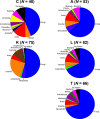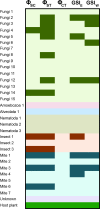Biogeographic barriers drive co-diversification within associated eukaryotes of the Sarracenia alata pitcher plant system
- PMID: 26788436
- PMCID: PMC4715430
- DOI: 10.7717/peerj.1576
Biogeographic barriers drive co-diversification within associated eukaryotes of the Sarracenia alata pitcher plant system
Abstract
Understanding if the members of an ecological community have co-diversified is a central concern of evolutionary biology, as co-diversification suggests prolonged association and possible coevolution. By sampling associated species from an ecosystem, researchers can better understand how abiotic and biotic factors influence diversification in a region. In particular, studies of co-distributed species that interact ecologically can allow us to disentangle the effect of how historical processes have helped shape community level structure and interactions. Here we investigate the Sarracenia alata pitcher plant system, an ecological community where many species from disparate taxonomic groups live inside the fluid-filled pitcher leaves. Direct sequencing of the eukaryotes present in the pitcher plant fluid enables us to better understand how a host plant can shape and contribute to the genetic structure of its associated inquilines, and to ask whether genetic variation in the taxa are structured in a similar manner to the host plant. We used 454 amplicon-based metagenomics to demonstrate that the pattern of genetic diversity in many, but not all, of the eukaryotic community is similar to that of S. alata, providing evidence that associated eukaryotes share an evolutionary history with the host pitcher plant. Our work provides further evidence that a host plant can influence the evolution of its associated commensals.
Keywords: 454 sequencing; Co-diversification; Metagenomics; Phylogeography; Sarracenia.
Conflict of interest statement
The authors declare there are no competing interests.
Figures




Similar articles
-
Diverse microbial communities hosted by the model carnivorous pitcher plant Sarracenia purpurea: analysis of both bacterial and eukaryotic composition across distinct host plant populations.PeerJ. 2019 Feb 18;7:e6392. doi: 10.7717/peerj.6392. eCollection 2019. PeerJ. 2019. PMID: 30805246 Free PMC article.
-
Phylogeographic concordance factors quantify phylogeographic congruence among co-distributed species in the Sarracenia alata pitcher plant system.Evolution. 2016 May;70(5):1105-19. doi: 10.1111/evo.12924. Epub 2016 Apr 29. Evolution. 2016. PMID: 27076412
-
Do ecological communities disperse across biogeographic barriers as a unit?Mol Ecol. 2017 Jul;26(13):3533-3545. doi: 10.1111/mec.14137. Epub 2017 May 5. Mol Ecol. 2017. PMID: 28390087
-
The microbial Phyllogeography of the carnivorous plant Sarracenia alata.Microb Ecol. 2011 May;61(4):750-8. doi: 10.1007/s00248-011-9832-9. Epub 2011 Mar 24. Microb Ecol. 2011. PMID: 21431933
-
Phylogeography and biogeography of the lower Central American Neotropics: diversification between two continents and between two seas.Biol Rev Camb Philos Soc. 2014 Nov;89(4):767-90. doi: 10.1111/brv.12076. Epub 2014 Feb 3. Biol Rev Camb Philos Soc. 2014. PMID: 24495219 Review.
Cited by
-
Phenotypes in phylogeography: Species' traits, environmental variation, and vertebrate diversification.Proc Natl Acad Sci U S A. 2016 Jul 19;113(29):8041-8. doi: 10.1073/pnas.1602237113. Proc Natl Acad Sci U S A. 2016. PMID: 27432983 Free PMC article. Review.
-
Bacterial Recruitment to Carnivorous Pitcher Plant Communities: Identifying Sources Influencing Plant Microbiome Composition and Function.Front Microbiol. 2022 Mar 14;13:791079. doi: 10.3389/fmicb.2022.791079. eCollection 2022. Front Microbiol. 2022. PMID: 35359741 Free PMC article.
-
Diverse microbial communities hosted by the model carnivorous pitcher plant Sarracenia purpurea: analysis of both bacterial and eukaryotic composition across distinct host plant populations.PeerJ. 2019 Feb 18;7:e6392. doi: 10.7717/peerj.6392. eCollection 2019. PeerJ. 2019. PMID: 30805246 Free PMC article.
-
Conceptual and empirical advances in Neotropical biodiversity research.PeerJ. 2018 Oct 4;6:e5644. doi: 10.7717/peerj.5644. eCollection 2018. PeerJ. 2018. PMID: 30310740 Free PMC article.
-
Illuminating protist diversity in pitcher plants and bromeliad tanks.PLoS One. 2022 Jul 27;17(7):e0270913. doi: 10.1371/journal.pone.0270913. eCollection 2022. PLoS One. 2022. PMID: 35895712 Free PMC article.
References
-
- Addicott JF. Predation and prey community structure: an experimental study of the effect of larvae on the protozoan communities of pitcher plants. Ecology. 1974;55:475–492. doi: 10.2307/1935141. - DOI
-
- Avise JC. Phylogeography: the history and formation of species. Cambridge: Harvard University Press; 2000.
-
- Avise JC, Arnold J, Ball RM, Bermingham E, Lamb T, Neigel JE, Reeb CA, Saunders NC. Intraspecific phylogeography: the mitochondrial DNA bridge between population genetics and systematics. Annual Review of Ecology and Systematics. 1987;18:489–522. doi: 10.1146/annurev.es.18.110187.002421. - DOI
-
- Bell RC, MacKenzie JB, Hickerson MJ, Chavarria KL, Cunningham M, Williams S, Moritz C. Comparative multi-locus phylogeography confirms multiple vicariance events in co-distributed rainforest frogs. Proceedings of the Royal Society B: Biological Sciences. 2012;279:991–999. doi: 10.1038/rspb.2011.1229. - DOI - PMC - PubMed
Grants and funding
LinkOut - more resources
Full Text Sources
Other Literature Sources

